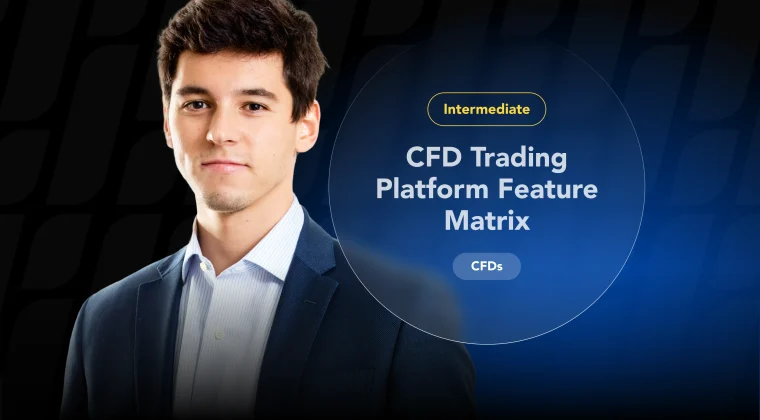-
- Trading Platforms
- PU Prime App
- MetaTrader 5
- MetaTrader 4
- PU Copy Trading
- Web Trader
- PU Social
-
- Trading Conditions
- Account Types
- Spreads, Costs & Swaps
- Deposits & Withdrawals
- Fee & Charges
- Trading Hours

The best CFD (Contract for Difference) trading platforms make it easy to place trades, manage risk, and access a wide range of markets all in one place.
Whether you’re trading shares, commodities, indices, or forex, your platform should offer the tools and support you need to trade with confidence.
CFDs let you go long or short, use leverage, and take advantage of short-term price movements without owning the asset.
That flexibility is powerful, but it also comes with risks.
This guide covers how CFD platforms work, which features matter most, and what to consider before you start trading.
A CFD trading platform is the main tool you’ll use to place and manage trades.
It connects you directly to the market, providing the features you need to act on price movements.
Whether you’re speculating on forex, stocks, or commodities, the platform is where everything happens in real time.
At a basic level, it lets you open and close positions, view live prices, analyse charts, set stop losses, and monitor your portfolio.
But a well-designed platform does more than just process orders.
It helps you stay on top of market shifts, manage risk quickly, and make more informed decisions as conditions change.
Most modern platforms cater to a wide range of traders, from beginners to experienced professionals.
Common features include:
The best platform for you will depend on your trading style, but it’s not only about having the right tools.
You want a platform with strong regulations that keep your funds secure, transparent fees to help you manage costs, and responsive support when markets move fast. f
The right CFD trading platform helps you trade more confidently, manage risk, and stay ahead of market moves.
PU Prime offers many of the features traders value most:
Each of these features helps create a smoother, safer, and more informed trading experience, whether you’re just starting out or already trading at scale.
CFD trading lets you speculate on price movements without owning the actual asset.
You’re entering a contract with your broker to settle the difference in price between when you open and close a trade.
Here’s how it works in practice:
CFD trading is fast-moving and powerful, but it demands clear risk awareness and a disciplined strategy.
Not all traders have the same experience or goals, so most CFD platforms offer a few different account types to suit different needs:
These are great if you’re starting or want to try the platform first.
You trade using virtual funds, so there’s no risk, just a chance to learn how the tools work and test your strategies.
These standard accounts are designed for individual traders.
They come with built-in protections like negative balance protection and usually offer access to a wide range of assets and trading tools.
This is the most common entry point for everyday traders.
If you have experience and meet certain criteria (like trading volume or financial background), you may be eligible for a professional account.
These often offer higher leverage and extra features, but with fewer regulatory protections, so they’re best suited to confident, active traders.
Some platforms offer a personal account manager if you’re trading at a higher level or have a larger account.
This gives you more tailored support and sometimes early access to insights or platform features.
Choosing the correct account type ensures you’re trading with tools and settings that match your experience, risk tolerance, and financial goals.
On PU Prime, you can start with a demo, open a retail account, or apply for a professional upgrade once you’re ready.
When it comes to CFD trading, a platform’s credibility depends heavily on how well it’s regulated and what protections it offers you as a trader.
Always check that your broker is regulated and take a few minutes to review what protections they offer.
Fees can vary between platforms, and understanding them upfront helps you manage your trading costs and avoid surprises later. Here are the main charges to watch for:
Spreads: This is the difference between the buy and sell price. It’s how many platforms make their money.
Tighter spreads mean better value, especially on high-volume instruments like forex pairs or major indices. PU Prime, for example, offers ultra-low spreads on popular pairs.
Commissions: Some platforms charge a separate fee per trade, usually when trading shares or specific asset classes.
Always check whether spreads alone apply or if a commission is added.
Overnight (swap) fees: If you hold a position overnight, you might be charged a small interest fee.
This reflects the cost of borrowing to keep your trade open with leverage.
Inactivity fees: If you don’t log in or trade for a certain period, some platforms may charge a maintenance fee.
It’s worth checking the terms so you’re not caught off guard.
PU Prime, for example, does not charge this fee.
Withdrawal fees: Certain withdrawal methods might come with a processing fee. Others may be free.
The best CFD trading platforms are upfront about their fees so you can focus on trading, not worrying about hidden costs.
Always read the fee schedule before you commit.
The best CFD platform for you depends on how you trade, what you trade, and the kind of support you need. Here’s what to look for:
Fast-moving day traders and scalpers need lightning-fast execution.
If you hold trades longer, you might care more about strong charting tools and strategy planning.
If you’re new, look for a user-friendly platform with clear layouts, a demo account, and built-in education, like tutorials, trading guides, or market explainers available directly within the platform.
More experienced traders may want tools for algorithmic trading or direct market access.
Ensure your platform provides access to the markets you’re interested in, including major forex pairs, stock indices, commodities, and ETFs.
Choose a broker that’s licensed in your country or region.
It gives you legal protections and ensures your funds are held securely.
Look beyond spreads. Consider commissions, overnight (swap) fees, withdrawal costs, and even inactivity fees.
Transparent platforms like PU Prime publish all of this clearly.
A reliable platform should work seamlessly on desktop, mobile, and browser, so you can trade on the go without glitches.
If things go wrong or markets move fast, you want to speak to someone who knows what they’re doing. Look for brokers with 24/5 support and positive reviews.
User ratings, industry awards, and real-time responsiveness can also give you clues about the platform’s reputation.
Most importantly, take time to explore your options before you commit.
Starting small and learning as you trade is key. With the right platform and a clear plan, you can grow your skills over time.
Yes, CFD trading comes with real risks, and it’s important to understand them before getting started:
The best approach is to start small, trade with a clear strategy, and only use money you can afford to lose. Risk management tools (like those offered on PU Prime) can help keep things in check.
Start with a free PU Prime demo account and practise risk-free. Explore real-time markets, test strategies, and get comfortable with the platform before trading live.
Are CFDs legal in my country?
CFDs are legal and regulated in countries like the UK, Australia, and across much of Europe. However, they’re banned in places like the US.
Always check your local rules before opening an account.
What can I trade as a CFD?
Most platforms let you trade forex pairs (like EUR/USD), stock indices, company shares, commodities, ETFs, and even cryptocurrencies, as CFDs.
What’s the minimum amount I need to start?
This varies across brokers and depends on the platform and account type that you choose.
Some let you start with as little as $50, while others may require $500 or more.
PU Prime offers an account type that allows you to start from as little as $20.
Can I trade with leverage?
Yes, most CFD platforms offer leverage.
The amount available depends on where you live.
For example, retail traders in the EU are limited to 30:1 on major forex pairs, while PU Prime’s maximum leverage is 1:1000.
What fees should I expect?
Common fees include spreads, overnight (swap) charges, and sometimes commissions, especially on share CFDs.
Some platforms also charge inactivity or withdrawal fees.
What’s the best platform for beginners?
Look for a platform that’s easy to use, offers a free demo account, has plenty of learning tools, educational resources and provides strong customer support.
PU Prime is a great option for beginners.
How do I analyse the market?
Most traders use technical analysis (charts and indicators), along with market news and economic calendars, all of which are available on most platforms.
Can I lose more than I invest?
If your account includes negative balance protection (common for retail traders), you can’t lose more than your deposit.
Without it, additional losses are possible.
How are profits and losses worked out?
It’s all about the price difference.
You earn or lose based on the difference between the opening and closing price of your CFD trade, multiplied by your trade size.
Step into the world of trading with confidence today. Open a free PU Prime live CFD trading account now to experience real-time market action, or refine your strategies risk-free with our demo account.
This content is for educational and informational purposes only and should not be considered investment advice, a personal recommendation, or an offer to buy or sell any financial instruments.
This material has been prepared without considering any individual investment objectives, financial situations. Any references to past performance of a financial instrument, index, or investment product are not indicative of future results.
PU Prime makes no representation as to the accuracy or completeness of this content and accepts no liability for any loss or damage arising from reliance on the information provided. Trading involves risk, and you should carefully consider your investment objectives and risk tolerance before making any trading decisions. Never invest more than you can afford to lose.

Trade forex, indices, metal, and more at industry-low spreads and lightning-fast execution.
Sign up for a PU Prime Live Account with our hassle-free process.
Effortlessly fund your account with a wide range of channels and accepted currencies.
Access hundreds of instruments under market-leading trading conditions.
Please note the Website is intended for individuals residing in jurisdictions where accessing the Website is permitted by law.
Please note that PU Prime and its affiliated entities are neither established nor operating in your home jurisdiction.
By clicking the "Acknowledge" button, you confirm that you are entering this website solely based on your initiative and not as a result of any specific marketing outreach. You wish to obtain information from this website which is provided on reverse solicitation in accordance with the laws of your home jurisdiction.
Thank You for Your Acknowledgement!
Ten en cuenta que el sitio web está destinado a personas que residen en jurisdicciones donde el acceso al sitio web está permitido por la ley.
Ten en cuenta que PU Prime y sus entidades afiliadas no están establecidas ni operan en tu jurisdicción de origen.
Al hacer clic en el botón "Aceptar", confirmas que estás ingresando a este sitio web por tu propia iniciativa y no como resultado de ningún esfuerzo de marketing específico. Deseas obtener información de este sitio web que se proporciona mediante solicitud inversa de acuerdo con las leyes de tu jurisdicción de origen.
Thank You for Your Acknowledgement!